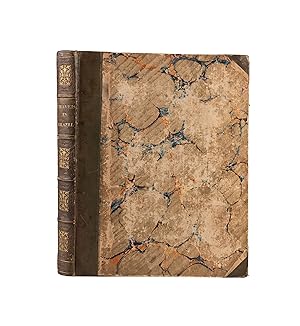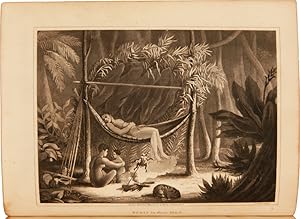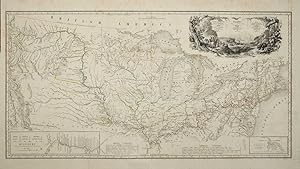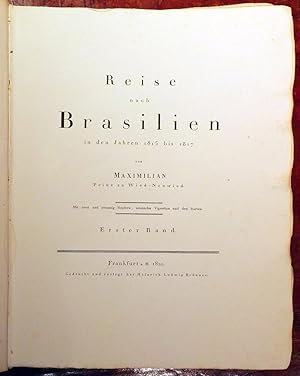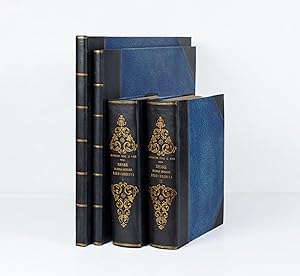Maximilian Wied Neuwied Prince (9 results)
Product Type
- All Product Types
- Books (7)
- Magazines & Periodicals
- Comics
- Sheet Music
- Art, Prints & Posters
- Photographs
- Maps (2)
- Manuscripts & Paper Collectibles
Condition
Binding
- All Bindings
- Hardcover (6)
- Softcover
Collectible Attributes
- First Edition (6)
- Signed
- Dust Jacket
- Seller-Supplied Images (6)
- Not Print on Demand (9)
Free Shipping
Seller Location
Seller Rating
-
Travels in Brazil, in 1815,1816, and 1817. translaten from the german, illustrated with engravings
Published by P^rinted for Richard Phillips, and Co. Bride Court, London, 1820
Seller: Libreria de Antano (ILAB & ABA Members), Miami, FL, U.S.A.
Full leather. Condition: Good. ills (illustrator). 8vo. 112 con 9 grabados pp. Una traducción del alemán que detalla las expediciones al interior de Brasil y Amazonia. El Príncipe Maximiliano de Wied-Neuwied viajó a través de Brasil desde 1815 hasta 1817, acompañado por los naturalistas Georg Freyreiss y Friedrich Sellow. Desde Río viajaron a Cabo Frio, a lo largo de la costa de Ilheus, y desde allí navegaron por el Jequitinhonha hasta las fronteras. de Minas Gerais, llegando finalmente a Bahía. Desde un punto de vista científico, esta expedición fue una de las más rentables del siglo XIX. Las enormes colecciones zoológicas que se reunieron se encuentran hoy en el Museo Americano de Historia Natural de Nueva York, adquiridas por ellos en 1870. Cuando apareció la obra, las copias se vendieron por mil francos, una suma extravagante en ese momento. A translation from the German detailing the expeditions into the interior of Brazil and Amazônia. "Prince Maximilian of Wied-Neuwied travelled through Brazil from 1815 to 1817, accompanied by the naturalists Georg Freyreiss and Friedrich Sellow. From Rio they journeyed to Cabo Frio, along the coast of Ilheus, and from there they sailed up the Jequitinhonha to the borders of Minas Gerais, finally reaching Bahia. From a scientific point of view this expedition was one of the most profitable of the nineteenth century. The enormous zoological collections which were assembled are today in the American Museum of Natural History of New York, acquired by them in 1870. When the work first appeared, copies were sold for one thousand francs, an extravagant sum at that time.
-
Travels in Brazil,
Publication Date: 1820
Seller: Maggs Bros. Ltd ABA, ILAB, PBFA, BA, London, United Kingdom
First Edition
in the Years 1815, 1816, 1817. First English edition. Engraved folding map & 6 sepia aquatints. 4to. Attractive contemporary half calf, marbled boards (these a trifle rubbed), spine gilt. viii, 335, [1]ads.pp. London, Henry Colburn, The first English edition of one of the ?classic? nineteenth-century travel accounts of Brazil, which was first issued in two thick quartos in Frankfurt. Prince Maximilian, in the company of the naturalists George Freyreiss and Friedrich Sellow, travelled throughout the eastern part of Brazil, from Rio de Janeiro to Bahia. Copies of this, the first English edition, were sometimes issued with an extra portrait not called for in the list of plates - this copy has none. Abbey (Travel), 705; Sabin, 47021; Borba II, p545.
-
TRAVELS IN BRAZIL, IN THE YEARS 1815, 1816, 1817
Published by Printed for Henry Colburn & Co., London, 1820
Seller: William Reese Company - Americana, New Haven, CT, U.S.A.
[iii]-x,335,[1]pp. plus six plates, portrait, and folding map. Lacks the half title. Quarto. Later blue morocco, boards ruled in gilt, spine gilt with raised bands, marbled edges. Binding shelf worn and lightly scuffed. Occasional light foxing to text, some offsetting from plates. Very good. The first English edition of this classic work, a 19th-century travel account of Brazil. "Prince Maximilian of Wied-Neuwied travelled through Brazil from 1815 to 1817, accompanied by the naturalists Georg Freyreiss and Friedrich Sellow. From Rio they journeyed to Cabo Frio, along the coast of Ilheus, and from there they sailed up the Jequitinhonha to the borders of Minas Geraes, finally reaching Bahia. From a scientific point of view this expedition was one of the most profitable of the nineteenth century. The enormous zoological collections which were assembled are today in the American Museum of Natural History of New York, acquired by them in 1870" - Borba de Moraes. This English translation covers only the first of two volumes of the original German edition, published in Frankfurt earlier the same year. Illustrations include six beautifully engraved plates. "The plates are principally illustrative of the habits and appearances of the Indian tribes he encountered" - Field. Also featured is a folding map, engraved and handcolored in outline, of "The East Coast of Brazil." This copy includes the engraved portrait of Prince Maximilian of Wied Neuwied, which is sometimes lacking. Prince Maximilian would later go on to travel in the United States and the upper Missouri River in 1832-34, accompanied by Swiss artist Karl Bodmer. Their travels were documented in Reise in das Innere Nord-America in den Jahren. (1839-1841), "the most important illustrated work of Western Americana, and the greatest colorplate book devoted to North American Indians" (Reese). This is the first copy we have handled, handsomely bound and splendidly illustrated, of this important travel account of Brazil. SABIN 47021. ABBEY 705. BORBA DE MORAES, pp.544-45. FIELD 1035. REESE, BEST OF THE WEST 73 (ref).
-
Carte Itineraire de Prince Maximilian de Wied dans l'interieur de l'Amerique Septentrionale de Boston a Missouri superieur &c. en 1832, 33 et 34. Reise Charte des Prinzen Maximilian zu Wied Map to illustrate the Route of Prince Maximilian of Wied in the interior of North America. From Boston to the Upper Missouri &c. in 1832, 33 & 34.
Published by Paris, 1839
Seller: Clive A. Burden Ltd., Chalfont St. Giles, BUCKS, United Kingdom
Map
No binding. Condition: Good. 415 x 810 mm., large folding map in early outline colour as issued, one or two light creases, some browning to upper margin and water stain to lower margins not affecting the map, otherwise in good condition with no major splits or tears. A fine example of this very rare map which accompanied the finest colour plate book on the North American Indian ever printed entitled 'Reise in das inner Nord-America .' It is particularly rare is it accompanied the text volumes printed to accompany the fine aquatint plates more often found. It charts one of the more remarkable voyages of exploration undertaken within the present United States. Prince Maximilian of Wied-Neuwied (1782-1867) was a noted German explorer, ethnologist and naturalist. Joining the Prussian army in 1800 he fought through the Napoleonic Wars and left at the end in 1815. An early friend of Alexander Humboldt Maximilian led his own expedition to Brazil in 1815-17. In 1832 after hiring the Swiss artist Karl Bodmer he set out again this time to the waters of the Missouri River and the Plains. The region was little known at the time. They started out from St. Louis and travelled on the 'Yellowstone', an American Fur Company steamboat stopping at their various forts. Changing vessels along the way they continued Fort Union, Fort Clark and Fort Mackenzie. They observed the Assiniboin, Cree, Mandan, Minatare and Crow peoples. From here they returned south reaching St. Louis in May 1834.Whilst Prince Maximilian returned to Germany to write his account Karl Bodmer travelled to Paris to prepare his famous aquatint plates from his collection of watercolours. Together their finished work would be considered one of the most sympathetic and accurate recordings of the Plains Indians issued just prior to their virtual extinction with a decade. This was ironically brought about by the very method used to document them in the first place. In 'The Plains Indians', the historian Paul H. Carlson states the smallpox outbreak was traced to contact between deckhands of the steamboats of the American Fur Company and the natives.Wheat records that Prince Maximilian was given a map in 1833 by Major Benjamin O'Fallon who was the nephew of William Clark author of the map who along with Meriwether Lewis had crossed the region to reach the Pacific Ocean earlier in the century. O'Fallon had joined Clark in 1808 and was also present on Stephen Long's expedition to the Rocky Mountains in 1819-20. By the time of Prince Maximilian expedition, he was one of the most experienced travellers in the region. No doubt the version he passed to the Prince would have been updated considerably since the Lewis and Clark expedition. The fact that the printed map includes the route of Long is clear indication of that. The Prince is said to have 'completed it and removed its deficiencies'. Since the publication of Wheat further research has identified that the cartographer was Lt. Col. William Thorn who used as a base map Henry Tanner's 'Map of the United States of America' published in 1837. The map includes large insets of the Missouri River lower left and one of the source of the Mississippi River 'According to Schoolcraft' lower right. The whole is finished with a dramatic title cartouche illustrating a buffalo hunting scene.Maximilian's insisted that the text be published in a deluxe edition, which made publishers wary. The popularity of such works was waning. Maximilian persisted and in 1839 the first text and prints were ready for distribution to a disappointingly few subscribers. A French edition in 1840-42 and the English translation in 1843 were no more successful. Bodmer spent a total of eight years supervising a group of the best French and Swiss etchers to produce the aquatints. The original copper plate for the map was recently found amongst the original watercolours in the Joslyn Art Museum, Omaha, Nebraska. Provenance: private German collection; private English collection. Abbey Travel 615; Field 103.
-
Reise nach Brasilien in den Jahren 1815 bis 1817.
Published by Frankfurt: Heinrich Ludwig Bronner, 1820-[1821]., 1821
Seller: Arader Galleries - AraderNYC, New York, NY, U.S.A.
First Edition
MAXIMILIAN ZU WIED-NEUWIED, Prince (1782-1867). Reise nach Brasilien in den Jahren 1815 bis 1817. Frankfurt: Heinrich Ludwig Bronner, 1820-[1821]. 3 volumes: 2 volumes text, 4to., (14 4/8 x 11 inches); and one atlas volume, portfolio (21 x 16 inches). 19 engraved plates in text volumes (chapter vignettes, printed on separate leaves), 20 (of 22) engraved plates, including 3 with original hand-colour, all after Maximilian, and 3 maps by Arrowsmith, including 2 folding with original hand-colour in outline (without plates 21 and 22). Uniformly bound in original drab printed paper boards (a bit worn) Provenance: with the near contemporary ownership inscription of Dr. Verves on the front paste-down of volume one; the ink library stamp of Dr. M.J.E.M. Steyns of Otrecht on the front free endpaper of each text volume. First edition in rare original boards, possibly later issue with the maps and plates in one portfolio, rather than two, and with a printed overslip detailing the number of plates included - ie 22. ".from a scientific point of view . was one of the most profitable of the nineteenth century. The enormous zoological collections which were assembled are today in the American Museum of Natural History of New York. the account of this journey is a classic work" (Borba de Moraes II, p. 544). Maximilian arrived in Brazil in July of 1815 and spent two years there, "aided in his research by Wied family retainers Christian Simonis (estate gardner) and David Dreidoppel (huntsman and taxidermist) and two German scientists he met in Rio de Janeiro - ornithologist Georg Wilhelm Freyriss (1789-1825) and botanist Friedrich Sellow (1789-1831). The collections and records produced under very difficult field conditions in the eastern Brazilian rain forests were prodigious and formed the bases for important publications written by the prince in subsequent years at Neuwied" (Paul Schach, introduction to "The North American Journals of Prince Maximilian of Wied: May 1832April 1833", page xxxviii). Paul Schach in his "An Introduction to Maximilian, Prince and Scientist", states: "Reise nach Brasilien in de Jahren 1815 bis 1817" (Journey to Brazil in the Years 1815 to 1817), earned [Maximilian] high esteem not only for his exemplary description and classification of Brazilian animal life but also for his pioneering efforts in ethnology among the Botocudos and neighboring tribes. More than a century later, Professor Herber Baldus of Sao Paulo described Maximilian as 'the first scientist who ever came to Brazil for the express purpose of observing the aborigines in their native habitations. What he saw there he described thoroughly and independently of opinions of his time". "While he was working in the rain forests of Brazil, Prince Maximilian came to the realization that his observations recorded in the tropics, especially those on native peoples, needed to be supplemented with similar investigations in different New World environments. As he briefly noted in his "Reise nach Brasilien, "It would be very interesting for me to see the North-American Indian tribes for the purpose of comparing them with those of Brazil, and I intend therefore perhaps some day to undertake a journey there" (ibid, page xxxv). Palau 158782; Sabin 47018.
-
Reise nach Brasilien in den Jahren 1815 bis 1817.
Published by Frankfurt: Heinrich Ludwig Bronner, 1820-[1821]., 1821
Seller: Arader Galleries - AraderNYC, New York, NY, U.S.A.
First Edition
3 volumes: 2 volumes text, 4to., (13 1/8 x 10 3/8 inches); and atlas volume, folio (13 7/8 x 18 6/8 inches). 19 engraved plates in text volumes (chapter vignettes, printed on separate leaves), 22 engraved plates, including 5 hand-colored, and 3 maps, including one folding and two hand-colored in outline (short tear near mount of folding map of Brazil, plate 12- 14 in the Atlas volume darkened, with some mostly marginal spotting). Contemporary half sheep (inner hinges cracked). Provenance: with the ink library stamps of Furstliche Bibliothek Donaueschingen on the versos of the title-pages of the text volumes, and the front free endpaper of the atlas volume. First edition, and an attractive copy. Accompanied by the naturalists George Freyreiss and Friedrich Sellow, Prince Maximilian's expedition to Brazil in 1815-1817 ".from a scientific point of view . was one of the most profitable of the nineteenth century. The enormous zoological collections which were assembled are today in the American Museum of Natural History of New York. the account of this journey is a classic work" (Borba de Moraes II, p. 544). Palau 158782; Sabin 47018. Catalogued by Kate Hunter.
-
Reise nach Brasilien in den Jahren 1815 bis 1817.
Published by Frankfurt: Heinrich Ludwig Bronner, 1820-[1821]., 1821
Seller: Arader Galleries - AraderNYC, New York, NY, U.S.A.
First Edition
4 volumes: 2 volumes text, 4to., (13 1/8 x 10 inches); and 2 atlas volumes, portfolio (21 x 16 inches). 19 engraved plates in text volumes (chapter vignettes, printed on separate leaves), 22 engraved plates, including 5 with original hand-colour, all after Maximilian, and 3 maps by Arrowsmith, including one folding and two with original hand-colour in outline. Uniformly bound in original drab printed paper boards, the portfolios each with remains of two pairs of silk ties. Provenance: with the near contemporary ink armorial library stamp of Lauterbach on the title-pages, and small red morocco labels of the spines of the text volumes; with the small printed library label of Carlos R. Linga on the front paste-down of the text volumes; with Christie's New York 19 December 2002, lot 191 A MAGNIFICENT EXAMPLE IN ORIGINAL BOARDS. First edition, and an attractive copy. ".from a scientific point of view . was one of the most profitable of the nineteenth century. The enormous zoological collections which were assembled are today in the American Museum of Natural History of New York. the account of this journey is a classic work" (Borba de Moraes II, p. 544). Maximilian arrived in Brazil in July of 1815 and spent two years there, "aided in his research by Wied family retainers Christian Simonis (estate gardner) and David Dreidoppel (huntsman and taxidermist) and two German scientists he met in Rio de Janeiro - ornithologist Georg Wilhelm Freyriss (1789-1825) and botanist Friedrich Sellow (1789-1831). The collections and records produced under very difficult field conditions in the eastern Brazilian rain forests were prodigious and formed the bases for important publications written by the prince in subsequent years at Neuwied" (Paul Schach, introduction to "The North American Journals of Prince Maximilian of Wied: May 1832April 1833", page xxxviii). Paul Schach in his "An Introduction to Maximilian, Prince and Scientist", states: "Reise nach Brasilien in de Jahren 1815 bis 1817" (Journey to Brazil in the Years 1815 to 1817), earned [Maximilian] high esteem not only for his exemplary description and classification of Brazilian animal life but also for his pioneering efforts in ethnology among the Botocudos and neighboring tribes. More than a century later, Professor Herber Baldus of Sao Paulo described Maximilian as 'the first scientist who ever came to Brazil for the express purpose of observing the aborigines in their native habitations. What he saw there he described thoroughly and independently of opinions of his time". "While he was working in the rain forests of Brazil, Prince Maximilian came to the realization that his observations recorded in the tropics, especially those on native peoples, needed to be supplemented with similar investigations in different New World environments. As he briefly noted in his "Reise nach Brasilien, "It would be very interesting for me to see the North-American Indian tribes for the purpose of comparing them with those of Brazil, and I intend therefore perhaps some day to undertake a journey there" (ibid, page xxxv). Palau 158782; Sabin 47018. Catalogued by Kate Hunter.
-
Reise in das innere Nord-America in den Jahren 1832 bis 1834 von Maximilian Prinz zu Wied. Mit 48 Kupfern, 33 Vignetten, vielen Holzschnitten und einer Charte
Published by J. Hoelscher, 1839
Seller: Arader Books, New York, NY, U.S.A.
First Edition
Hardcover. Condition: Very Good. 1st Edition. THE GOLDEN SET, COLORED, WITH THE PUBLISHER'S WRAPPERS. Four volumes (two text, two plates). Coblenz: J. Hoelscher; 1839-41. Text-volumes: quarto (12 7/16" x 10 1/16", 316mm x 256mm). Vignettes: oblong folio (17" x 22 ¼", 431mm x 563mm). Tableaux: oblong folio (18 1/16" x 24 3/8", 459mm x 619mm). [Full collation available.] With 81 hand-colored aquatint-engraved plates, a lithographed chart and a lithographed map, hand-colored in outline. Bound in modern half black morocco gilt over blue paste-paper. On the text volumes' spine, author, title and number gilt within scrollwork. Top edges of the text-block gilt, fore and lower edges untrimmed. On the two plate volumes, author and title gilt to black morocco on the front boards. On the spines, 7 pairs of gilt fillets. [Full condition report available.] Very good, with scattered faults. Alexander Philipp Maximilian of Wied-Neuwied (1782-1867) was a protégé of Alexander von Humboldt, the all-encompassing man of Enlightenment science, who passed on to the young princeling his own passion for exploration. Indeed, Humboldt's travels through the Americas 1799-1804 sparked Prince Maximilian -- born the grandson of the ruling prince, and his father's fifth son; i.e., with no chance of ruling -- to do the same. Self-funded, Maximilian set off for Brazil 1815-1817, that trip being published from 1820 through 1850. Encouraged by his success, Maximilian made a second trip to America -- this through North America, getting as far west as Ft. McKenzie in Montana -- from 1832 to 1834, and now accompanied by the Swiss painter Karl Bodmer (1809-1893). The combination of the Humboldt-trained prince and the superbly sensitive artist Bodmer produced the best account of the American West, free from jingoism and agenda. Production of the work was lengthy, costly and complex (the Joslyn Art Museum's Karl Bodmer's North American Prints, edited by Brandon K. Ruud, is indispensable for its analysis). The question of coloration is vexatious to collectors, but Ruud corrects the "misinformation" that only the 46 subscribers' sets were fully colored; he estimates in fact that between 100 and 200 sets were colored in the XIXc either by Hölscher or the English (Ackermann) or French (Bertrand) publishers. Earlier cataloguers of the present item have called it "a later compiled set with resulting variance to margins, blind stamps and paper stock." The question of margins (generally about a centimeter along the long edge) is begged by the exceptional size of our set's plates; our set's Vignettes are some 5 ½" taller and wider than the Bobins set's. As with so many XIXc plate-books issued in parts, there was some natural variation in the size of the finished sheets; most were likely trimmed down to a uniform size, but the present set -- especially the large Vignettes -- seems not to have been. The variance in blind stamps is slight; 91% have the C. Bodmer control stamp, 5% have the earlier Ch. Bodmer stamp and only 3 (4%) are unstamped. I cannot detect variation in the paper stock (although some have tanned and others have not). Thanks to Ruud 2004, one can now make definitive study of the states of the plates (a spreadsheet is available). In the present set, 69 (85%) of the plates are in state 1, 11 are in state 2 (Tableaux 1, 18, 22, 42 and 46; Vignettes 1, 2, 4, 10, 12 and 18) and 1 in state 3 (Tableau 17). Crucially, none of the plates has the date, which is the hallmark of a later set. The set was purchased at the Sotheby's New York sale of John Golden (22 November 2022, lot 48), "Book Illustration in the Age of Scientific Discovery." Completely colored sets receive Howes's highest scarcity rating: dd ("superlatively rare books, almost unobtainable"). Abbey 615; Howes M 443a; Sabin 47014; Wagner-Camp 76:1. Ruud, Brandon K. (ed.). Karl Bodmer's North American Prints. Omaha, Lincoln and London: University of Nebraska Press for the Joslyn Art Museum, 2004.
-
Reise in das Innere Nord-America in den Jahren 1832 bis 1834 von Maximilian Prinz zu Wied
Published by J. Hoelscher, Coblenz, 1839
Seller: Clive A. Burden Ltd., Chalfont St. Giles, BUCKS, United Kingdom
Map First Edition
No binding. Condition: Very Good. FIRST EDITION IN COLOUR. Text in two large quarto volumes (330 x 280 mm. ea.), recent matching half calf, brown moirà cloth boards, spines with gilt ruled raised bands with gilt titles, with central blind embossed compartments. With titles, half-titles, table of contents, list of subscribers, pp. [16], 654, [2]; [24], 688, [2], containing over 40 woodblock engravings set within the text, with the large folding map (415 x 810 mm.) in early outline colour often missing. Tableau atlas in oblong portfolio (430 x 610 mm.), in contemporary half calf binding, brown moirà cloth boards, gilt panelled with central gilt title within ornate frame, spine with gilt ruled raised bands, compartments with ornate blind central feature, interior of both boards with publisher's green moirà paper, extremities lightly rubbed. Containing 48 plates consisting of 48 Tableau engravings on steel and copper in excellent old colour heightened with gum Arabic and a table illustrating the temperatures at Fort Union and Fort Clark (often lacking), 41 plates in their first state, the remainder early states, minor repairs, none affecting plate area, with protective tissue, all with publisher's blind stamp. Vignette atlas in oblong portfolio (330 x 485 mm.), in contemporary half calf binding, brown moirà cloth boards, gilt panelled with central gilt title within ornate frame, rebacked to style, interior of both boards with publisher's green moirà paper. Containing 33 Vignette engravings on steel and copper in excellent old colour heightened with gum Arabic, 30 plates in their first state, the remainder early states, minor repairs, none affecting plate area, with protective tissue, all with publisher's blind stamp. The first edition of the narrative of the travels of Prince Maximilian zu Wied-Neuwied (1782-1867) up the Missouri River and the Plains in 1832-34. It is accompanied by the magnificent series of portraits and scenes of Indian life just prior to its loss forever. Many of them are amongst the most iconic images of the American West. The artist accompanying him on the voyage was Karl Bodmer (1809-93). Ron Tyler called him 'the most accomplished artist to paint them [American Indians]'.Prince Maximilian was a student of natural history and had studied under the same tutor as another great scientist, Alexander von Humboldt. Their field of study was anthropology and how the spread of humans around the globe had led to so many different races. Maximilian's trip was to attempt to answer some of those questions. A veteran of the Napoleonic Wars he had already travelled to the Brazilian jungle 1815-17. The prints accompany that work were derided and for his travels to America he wrote 'I would want to bring along a draftsman who would not be too much of a burden on my pocketbook, a landscape painter but also able to depict figures correctly and accurately, especially the Indians.' Maximilian met the young Bodmer in January 1832 and after agreeing to the voyage they departed in May of the same year.Arriving in Boston they made their way to St. Louis by April 1833 from where they headed up the Missouri in the Yellow Stone, an American Fur Company steamboat which had carried George Catlin the previous year. The region was little known at the time. Changing vessels along the way they continued to Fort Union, Fort Clark, and Fort Mackenzie. They observed the Assiniboin, Cree, Mandan, Minatare, and Crow peoples. They went beyond Fort Union into Blackfoot country in present day Montana. After a dreadful return journey, they reached St. Louis on 16 July 1834, Maximilian suffering badly from scurvy. Maximilian had lost much of his natural history and ethnographic material in the explosion of the Assiniboine on the Missouri. However, Bodmer's more than 400 watercolours and sketches.Whilst Prince Maximilian returned to Germany to write his account Karl Bodmer travelled to Paris to prepare his famous aquatint plates from his collection of watercolours. After several.



